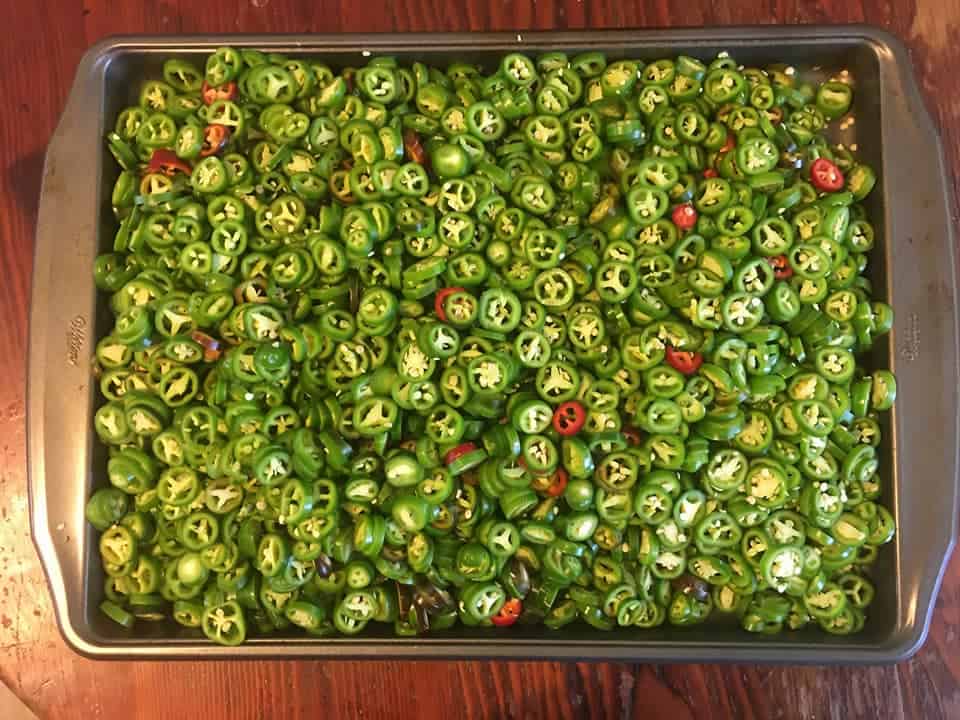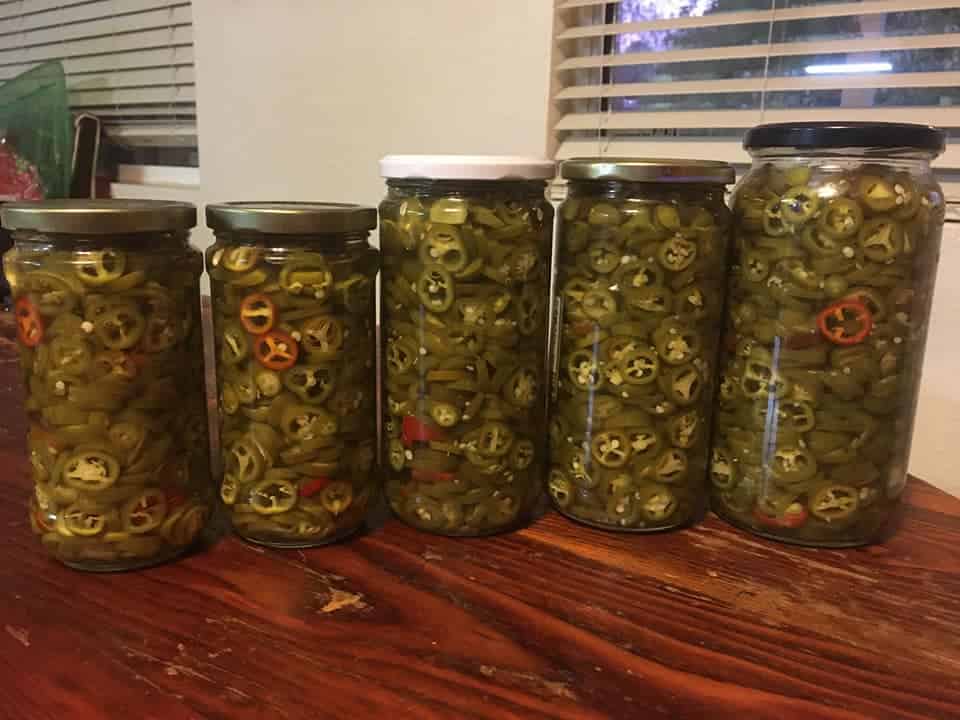There’s nothing like the bite of a good pickled jalapeño – crisp, tangy, and just spicy enough to wake up whatever you’re eating.
Store-bought ones are fine, but they often taste flat or too salty. When you make them at home, you control the flavor and get that fresh crunch that jars from the store just don’t have.
The process is way simpler than it looks. A quick brine, a few basic ingredients, and you’ll have jalapeños that taste like they belong on everything from tacos to scrambled eggs.
This isn’t some long, drawn-out canning project either – just a quick pickle that’s ready to eat the same day.
What Are Pickled Jalapeños?

Pickled jalapeños are fresh peppers preserved in a vinegar brine made with water, salt, and sometimes sugar.
The vinegar doesn’t just add tang – it keeps the peppers safe to eat by creating a high-acid environment that prevents harmful bacteria.
Love Pickling? This is part of my How to Pickle Everything series! Check out more recipes:
- Quick Pickled Radishes Recipe
- Easy Pickled Beets Recipe
- Homemade Pickled Okra Recipe
- How to Make Pickled Cabbage (Only 20 Minutes!)
- How to Make Pickled Cucumbers at Home
- Pickled Garlic Recipe
- Easy Pickled Banana Peppers Recipe
- Quick Pickled Carrots Recipe
- How to Make Pickled Asparagus at Home
- How to Make Pickled Ginger (Gari) at Home
- How to Make Pickled Cauliflower
- Crisp Pickled Green Beans Recipe
- Homemade Pickled Eggs with Beets
- Easy Pickled Cherry Tomatoes (No Canning Needed)
Unlike raw jalapeños, the pickled version has a softer bite and a mellowed heat, making them perfect on tacos, burgers, sandwiches, nachos, and even eggs.
Quick Pickling vs. Canning
This recipe is meant for quick pickling, which means the jalapeños are stored in the fridge rather than sealed for long-term shelf storage.
Quick pickling is simple – just pour the hot brine over the peppers, let them cool, and refrigerate. It’s safe, fast, and the peppers are ready to eat within hours.
Canning, on the other hand, is a different process. It involves using a hot water bath to create a vacuum seal, which allows the jars to be stored at room temperature for months.
While one or two people have used this recipe for water-bath canning, it’s not designed with canning safety guidelines in mind.
If you want to make shelf-stable canned jalapeños, use a tested recipe from the National Center for Home Food Preservation.
If you plan on eating these jalapeños within a few weeks or months (stored in the fridge), quick pickling is all you need.
Ingredients You’ll Need
You'll only need these to make a good jar of pickled jalapeños:
- 10 jalapeño peppers, thinly sliced (about ¼-inch thick)
- 2 garlic cloves, peeled (optional, adds savory depth)
- 1 cup distilled white vinegar (5% acidity only)
- 1 cup water
- ⅓ cup granulated sugar (balances heat and acidity; may reduce slightly, but don’t omit completely)
- 1 tablespoon pickling or canning salt (do not substitute flaky sea salt or table salt)
Optional flavor add-ins: 1 teaspoon mustard seeds, peppercorns, cumin seeds, or a bay leaf.
Tools and Equipment

Prepare these tools as well to make things easier:
- Two clean pint (16-ounce) jars with lids
- Small saucepan
- Sharp knife and cutting board
- Measuring cups and spoons
- Gloves (recommended for handling jalapeños – capsaicin can burn skin and eyes)
Step-by-Step Instructions
Making pickled jalapeños is straightforward. Just slice the peppers, make a quick brine, pour it over, and let them chill. Here’s how to do it right:
1. Prepare the Peppers and Jars

Begin by washing your jalapeños thoroughly under cool running water to remove any dirt or residue from the skin.
Put on gloves before slicing to protect your hands from the spicy oils. Using a sharp knife, cut the peppers into even ¼-inch rounds.
Slices of this thickness are ideal because they allow the brine to penetrate quickly without losing too much crunch.
Place the jalapeño slices into two clean pint-size jars, filling each one about three-quarters of the way full.
If you enjoy a hint of savory flavor, add one peeled and lightly smashed garlic clove to each jar. Make sure your jars and lids are clean and dry before filling, as this helps prevent spoilage.
2. Make the Brine
In a small saucepan, combine 1 cup of distilled white vinegar (5% acidity), 1 cup of water, ⅓ cup of granulated sugar, and 1 tablespoon of pickling or canning salt.
Turn the heat to medium and stir the mixture gently until the sugar and salt dissolve completely. The goal here is to warm the brine enough for everything to blend, but not to let it boil.
A boiling brine can make the flavor too sharp and may soften the peppers more than desired.
If you’d like to add spices such as mustard seeds, cumin seeds, peppercorns, or a bay leaf, add them to the pot now so they infuse while the brine is hot.
3. Combine and Cool
Once the brine is ready, carefully pour it over the jars of sliced jalapeños. Be sure to pour slowly so the hot liquid covers the peppers evenly and reduces air pockets.
Use a clean spoon or the back of a fork to gently press the slices down so they are completely submerged under the liquid.
This step is important because peppers exposed to air may spoil more quickly. Once the jars are filled, allow them to sit uncovered at room temperature until they have cooled completely.
This cooling period helps the peppers begin absorbing the brine and keeps the glass from cracking when refrigerated.
4. Refrigerate
After the jars have cooled fully, screw the lids on tightly and place them in the refrigerator right away.
You may be tempted to taste them immediately, and while they are safe to eat after about 30 minutes, the flavor improves significantly if you let them sit for several hours or overnight.
The longer the peppers rest in the brine, the more the flavors deepen and mellow.
For best results, store the jars in the coldest part of your fridge, and always keep the peppers submerged under the brine between uses.
How Long Do Pickled Jalapeños Last?

Pickled jalapeños offer their best flavor and crunch within the first 2 to 4 weeks.
Stored properly in the refrigerator (below 40 °F / 4 °C) and fully submerged in brine, they remain safe to eat for up to 2–3 months, though texture and flavor may gradually diminish.
Signs of Spoilage – Discard Immediately If You Spot:
- Cloudy brine or murkiness
- Mold on the peppers or at the surface
- Slimy or sticky texture
- Unpleasant, sour, or fermenting odor
- Fizzing or bubbling in the jar
- Bulging or domed lid
Storage Tips for Safety and Freshness:
- Always use clean utensils to remove pickles – this helps prevent contamination.
- After each use, seal the lid tightly and keep the peppers fully submerged in brine.
- Write the date on the jar when you first made it. For the best taste and texture, aim to use your pickled jalapeños within 3 months – even if they appear safe to eat.
Serving Ideas

Pickled jalapeños can add a tangy kick to almost anything. Here are a few easy ways to use them:
- Tacos and burritos: A handful of slices adds the perfect spicy bite.
- Burgers and sandwiches: Layer them for extra crunch and heat.
- Nachos: Scatter them over melted cheese for that classic flavor.
- Salads: Chop them up to give your greens some zip.
- Pizza: A few slices on top bring balance to rich, cheesy toppings.
- Egg dishes: Mix them into scrambled eggs, omelets, or breakfast burritos.
- Dips and spreads: Stir them into guacamole, salsa, or cream cheese dips for extra punch.
Start Your First Batch of Pickled Jalapeños Today!
Making your own pickled jalapeños is as simple as slicing, simmering, and chilling.
With just a few basic ingredients and a quick brine, you get crisp, tangy peppers that beat anything from the store.
The best part is you can adjust the sweetness, spice, and flavor to match your taste. Try a batch today, and you’ll always have a jar ready to liven up tacos, sandwiches, or even a plain bowl of rice.
Frequently Asked Questions (FAQs)
Can I reduce the sugar or make these without sugar?
Yes – many people reduce sugar for a less sweet brine. However, sugar contributes to flavor and texture, so even a small amount is recommended.
The most important safety element is maintaining proper acidity with 5% vinegar and the correct salt ratio. Do not reduce those amounts unless using a tested recipe.
How do I make them less spicy?
To tone down the heat, remove the seeds and membranes before slicing. You can also mix in mild or sweet peppers (like bell peppers) to dilute the spiciness.
Can I use apple cider vinegar instead of white vinegar?
Yes – as long as the vinegar is 5% acidity (also labeled as “50 grain”). Both white distilled and cider vinegar are safe choices. Avoid using flavored, homemade, or unknown-strength vinegars since acidity may vary and food safety can’t be guaranteed.
Why are my pickled jalapeños turning soft?
Softness is unlikely due to pouring temperature alone. More common causes include lower-than-needed acidity (i.e., too much water or insufficient vinegar) or departures from a tested recipe.
To maintain crispness, always follow tested ingredient ratios and use 5% vinegar.
Can I pickle whole jalapeños with this recipe?
No – this recipe is designed for sliced jalapeños, which pickle quickly and evenly. Whole peppers require longer brine penetration and are better suited to methods designed for hot-pack or canned jalapeño rings, like those provided separately by NCHFP.
